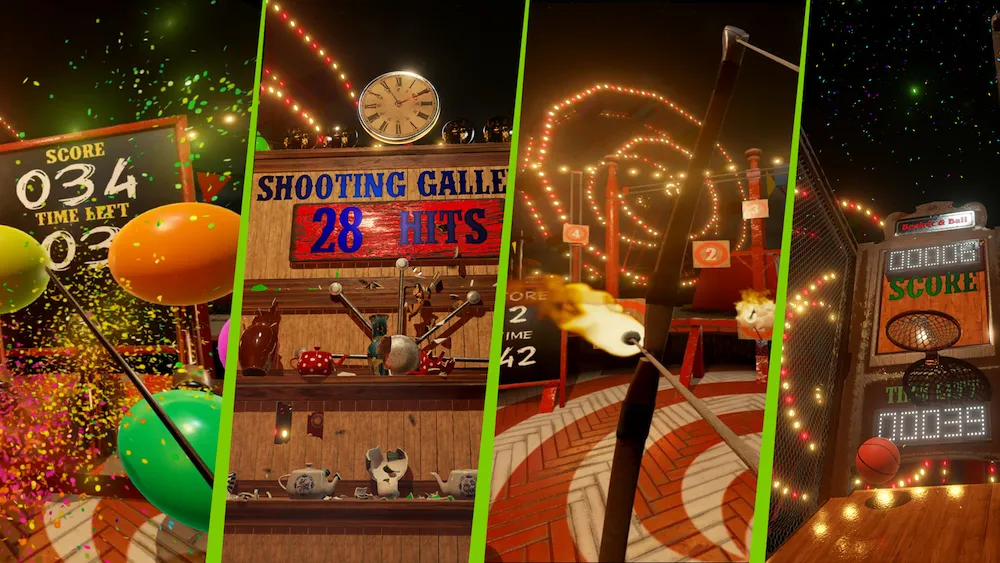I hold my comically large mallet loosely in my right hand, but I’m not swinging it at the creatures popping up out of the machine. The game says “whack-a-mole” and so I know I should be, you know, whacking the odd little creatures popping up before me, but I can’t. All I can do is stare and try to work out why they are unsettling me so much.
I’ve spent hours and hours in VR at this point in my career. I’ve battled horrifying monsters, shot zombies, leaned around unknown corners only to be met by ghosts and ghouls, and yet these silly little arcade imps are putting me off more than any of those things. I tighten my grip on the hammer as the secret to their oddity finally clicks in my mind: it’s the hair.
[gfycat data_id=”DearestBronzeIbisbill”]
VR Funhouse is a collection of carnival-themed mini-games created by GPU manufacturer NVIDIA. The games themselves are trite, but fun, and include all the classics of a big outdoor festival. There are shooting galleries, punching machines, and archery challenges – because no VR mini-game collection is complete until it offers you a bow and arrow.
The purpose of these little contests is to show off NVIDIA’s new 3D graphic rendering techniques inside of a VR headset. A chalkboard sign greeting you as you begin the experience even lists the features it wants you to keep an eye out for. These include realistic projectile and destruction physics and, most importantly, a new hair engine.
You wouldn’t expect hair to be such a powerful or important part of creating an immersive virtual reality experience but, even after all my hours inside of a VR headset, the hair I saw being rendered through NVIDIA HairWorks in VR Funhouse gave me pause.
When I’m slaughtering zombies, avoiding ghosts, or staring down from some immense height in VR, I can always quell my fears by reminding myself it’s only a simulation. The realism of the hair on these odd little gremlins, however, was so convincing that it kept my brain from accepting my usual simulation-rejecting mantra. Losing the ability to believe without any shadow of doubt that what I’m seeing isn’t real was a more terrifying and unsettling VR experience than any undead nightmare or 50 foot fall had ever been for me.
Besides the reality-breaking hair of these trolls, VR Funhouse also showcases many of NVIDIA’s other VR rendering tricks. For example, any 3D graphics designer will tell you that it’s harder to get something to break properly than stay together. There are dozens of ceramics to shoot, bash, and otherwise destroy in VR Funhouse and they all shatter quite believably thanks to what NVIDIA calls “PhysX Destruction.”
Another game shows off “NVIDIA FleX Fluids.” During this challenge you’re responsible for blasting a series of clown heads in the mouth with green goo in order to fill a balloon (one of the odder sentences I’ve ever had to write). This is a fairly simple game, but the realistic arc of the goo combined with the obvious cohesion physics of the liquid make something basic into something revolutionary in terms of graphical skill and presentation.
[gfycat data_id=”GrandioseShabbyAustralianfreshwatercrocodile”]
There is also a balloon vs. sword challenge that tasks you with laying waste to as many 3D balloons as possible. When these puny plastic punks taste the deadly steel of your blade they explode while releasing confetti into the air. Confetti like this falls into the particle physics territory of 3D graphics and its one of the trickier feats to pull off. Seeing it work so well in VR was a highly encouraging moment considering that particle physics was one of the major selling points of the most recent and advanced batch of gaming consoles such as the PlayStation 4.
[gfycat data_id=”AnchoredRegularArawana”]
VR Funhouse showed me that the uncanny valley is real and when you face it in such an immersive context it can be a bit scary. It is also, however, a hugely inspirational example of the way in which 3D graphics and art design can be used to deepen immersion and create more believable VR experiences. Improved graphics may be the key to creating a world indistinguishable from our own.
As frightening as that might be, I say bring it on.


























